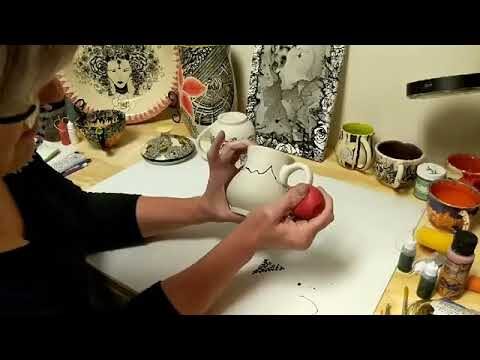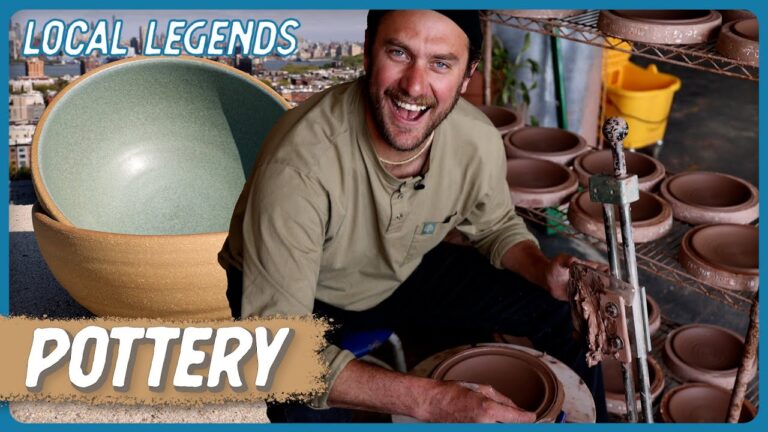In the world of pottery, mastering the art of glaze application on freehand pieces is a skill that can truly elevate your work to the next level. From creating unique patterns to achieving a flawless finish, the technique of glazing freehand pottery requires precision and creativity. In this article, we will explore the tips and tricks to help you perfect your glaze application, allowing you to create stunning and eye-catching pieces that showcase your talent and dedication to the craft.
Can pottery be glazed without a kiln?
Yes, you can glaze pottery without a kiln by using alternative methods such as a raku firing technique or pit firing. Raku firing involves heating the glazed pottery in a small kiln or open flame, then quickly removing it and placing it in a container with combustible materials to create unique and unpredictable finishes. Pit firing, on the other hand, involves burying the pottery in a pit with combustible materials and then igniting them to create a natural, earthy finish. These methods allow for beautiful and distinctive results without the need for a traditional kiln.
Glazing pottery without a kiln opens up a world of creative possibilities and allows for experimentation with different firing techniques. This can result in one-of-a-kind pieces that showcase unique textures and colors. Additionally, these alternative methods can be done outdoors and are a great way to connect with the natural elements, making the process of glazing pottery without a kiln not only practical, but also an enjoyable and enriching experience for artists and enthusiasts alike. So, if you don’t have access to a kiln, don’t let that stop you from glazing pottery – get creative and explore the fascinating world of alternative firing techniques.
What are three rules to keep in mind when working with glaze in ceramics?
When working with glaze in ceramics, it is important to follow three key rules to ensure a successful and professional finish. First, always make sure that the glaze is applied at least 1/4” away from the surface or kiln shelf. This will prevent any melting or sticking during the firing process. Additionally, be sure to wipe off any excess glaze with a wet sponge to achieve a clean and even application. Lastly, never allow glaze to touch the table or it will melt and adhere to the shelf, causing damage to both the piece and the kiln.
Adhering to these three rules when working with glaze in ceramics will help to avoid potential mishaps and ensure a high-quality result. By maintaining a safe distance of 1/4” from the surface or kiln shelf, wiping off excess glaze, and preventing any contact with the table, artists can confidently create beautiful and professional ceramic pieces. These rules serve as essential guidelines for achieving a successful glaze application and firing process, ultimately leading to stunning and durable finished products.
How can primitive pottery be glazed?
For primitive pottery, glazing is not an option due to the firing process not reaching high enough temperatures to melt glaze. Instead, achieving a glossy or smooth surface requires mastering the technique of polishing with a smooth stone. This can be most effectively done when the pot is slightly damp, known as being “leather hard”.
Perfecting Your Pottery with Freehand Glazing Techniques
Unlock your artistic potential and elevate your pottery creations with our expert tips on freehand glazing techniques. With a steady hand and a creative eye, you can transform ordinary clay pieces into stunning works of art. From intricate patterns to bold color combinations, the possibilities are endless when you master the art of freehand glazing.
Perfecting your pottery has never been easier with our step-by-step guide to mastering freehand glazing techniques. Whether you’re a beginner or a seasoned pro, our tips and tricks will help you take your pottery to the next level. Say goodbye to boring, plain ceramics and hello to beautifully decorated pieces that will impress everyone who sees them. Let your creativity shine through with freehand glazing and watch your pottery skills soar to new heights.
Elevate Your Pottery Game: Mastering Freehand Glaze Application
Are you ready to take your pottery skills to the next level? Elevate your pottery game by mastering the art of freehand glaze application. This advanced technique allows you to create unique and stunning designs on your pottery pieces, giving them a one-of-a-kind look that is sure to impress. Say goodbye to boring, plain pottery and hello to eye-catching, personalized pieces that showcase your creativity and skill.
Freehand glaze application is all about letting your imagination run wild and creating beautiful, intricate designs on your pottery. By mastering this technique, you can take your pottery game to new heights and set yourself apart as a skilled and innovative artist. Whether you’re a beginner looking to expand your skills or an experienced potter wanting to add a new dimension to your work, learning freehand glaze application is a game-changer.
With the right tools, techniques, and practice, you can become a master of freehand glaze application and transform your pottery into works of art. Elevate your pottery game by taking the time to perfect this technique and watch as your pieces become the talk of the town. Whether you’re creating functional pieces or decorative art, mastering freehand glaze application will take your pottery to the next level and leave a lasting impression on anyone who sees your work.
In mastering glaze application on freehand pottery, practice, patience, and attention to detail are key. Experiment with different techniques, colors, and finishes to create unique and stunning pieces. Remember to trust your instincts and embrace the imperfections that make each piece one-of-a-kind. With dedication and creativity, you can take your pottery to the next level and truly make it your own.



